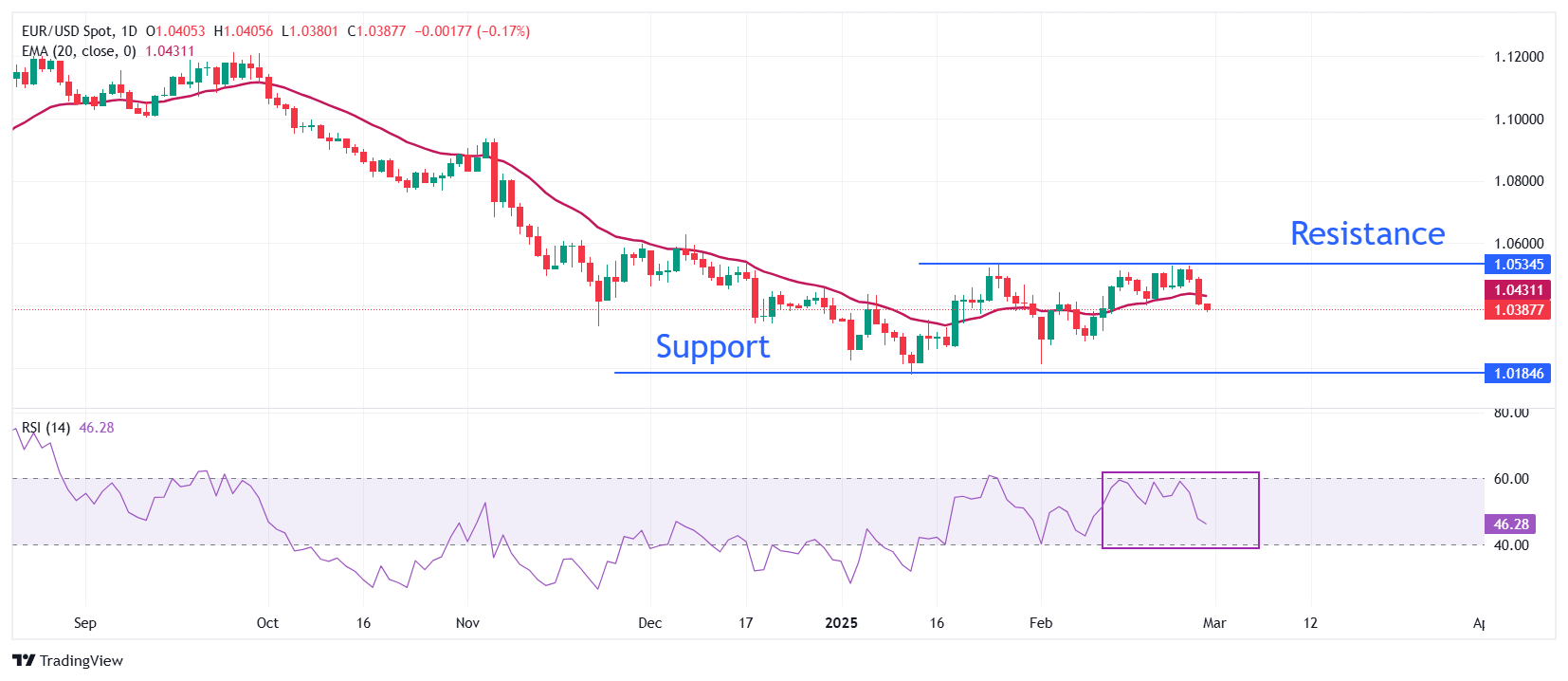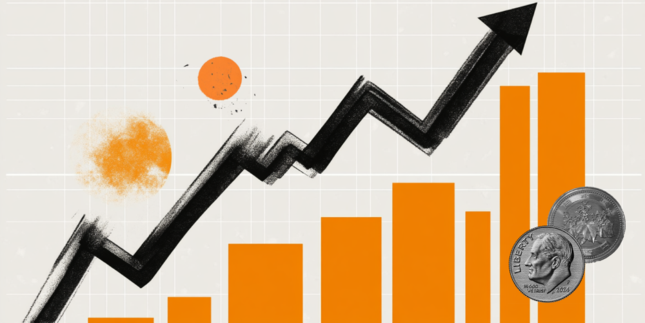EUR/USD trades cautiously as soft inflation data paves way for ECB rate cut
- EUR/USD trades with caution around 1.0400 as the US Dollar strengthened after US President Trump confirmed tariffs on his North American partners and China on Thursday.
- Tariffs on Canada and Mexico, and an additional 10% levy on China to go into effect on March 4, reciprocal tariffs on April 2.
- Investors await preliminary German inflation data for February and the US PCE inflation for January.
EUR/USD trades cautiously after the release of the preliminary inflation data of Germany's six states, France, and Italy for February. The major currency pair is expected to face selling pressure as the overall inflation data shows that price pressures decelerated, prompting hopes of an interest rate cut by the European Central Bank (ECB) in its upcoming monetary policy meeting on Thursday. Still, investors still await the flash German inflation data for February, which will be published at 13:00 GMT.
According to a February 19-27 Reuters poll, the ECB is certain to cut its Deposit Facility rate by 25 basis points (bps) to 2.5%. This would be the fifth interest rate cut by the central bank in a row. Dovish votes on the poll were based on fears that President Donald Trump’s tariff agenda will damage the Eurozone economic growth.
On Wednesday, President Trump threatened to impose tariffs on the Eurozone. Trump said the tariffs will be announced “very soon,” and it will be 25% on “cars and other things”. The German economy is expected to be the major victim of a trade war between the Eurozone and the US, being the fourth largest trading partner of the country.
The Reuters poll also showed that respondents were confident that the ECB would cut interest rates twice more by the middle of the year.
Meanwhile, German Retail Sales for January have come in higher than expected. The retail sales data, a key measure of consumer spending, rose by 0.2% in the month while it was expected to remain flat. In December, the consumer spending measure contracted by 1.6%. On a yearly basis, Retail Sales rose at a faster pace of 2.9% compared to the 1.8% growth seen in December.
Euro PRICE Today
The table below shows the percentage change of Euro (EUR) against listed major currencies today. Euro was the strongest against the New Zealand Dollar.
| USD | EUR | GBP | JPY | CAD | AUD | NZD | CHF | |
|---|---|---|---|---|---|---|---|---|
| USD | 0.08% | 0.15% | 0.41% | -0.03% | 0.40% | 0.61% | 0.38% | |
| EUR | -0.08% | 0.08% | 0.34% | -0.10% | 0.32% | 0.55% | 0.29% | |
| GBP | -0.15% | -0.08% | 0.25% | -0.17% | 0.24% | 0.48% | 0.22% | |
| JPY | -0.41% | -0.34% | -0.25% | -0.42% | -0.02% | 0.21% | -0.04% | |
| CAD | 0.03% | 0.10% | 0.17% | 0.42% | 0.41% | 0.65% | 0.39% | |
| AUD | -0.40% | -0.32% | -0.24% | 0.02% | -0.41% | 0.24% | -0.02% | |
| NZD | -0.61% | -0.55% | -0.48% | -0.21% | -0.65% | -0.24% | -0.26% | |
| CHF | -0.38% | -0.29% | -0.22% | 0.04% | -0.39% | 0.02% | 0.26% |
The heat map shows percentage changes of major currencies against each other. The base currency is picked from the left column, while the quote currency is picked from the top row. For example, if you pick the Euro from the left column and move along the horizontal line to the US Dollar, the percentage change displayed in the box will represent EUR (base)/USD (quote).
Daily digest market movers: EUR/USD stays under pressure due to fresh strength in US Dollar
- EUR/USD remains cautious after sliding to near the key support of 1.0400 in the European trading session on Friday. The major currency pair faces selling pressure as fresh tariff threats from United States (US) President Donald Trump have increased the appeal of safe-haven assets, such as the US Dollar (USD). The US Dollar Index (DXY), which tracks the Greenback’s value against six major currencies, extends its Thursday’s strong upward move to near 107.40.
- On Thursday, President Trump communicated from his account on Truth Social that 25% tariffs on Canada and Mexico are “coming into effect on March 4“ as “drugs are still pouring” into the economy from the borders of his North American allies. Trump also threatened to impose an “additional 10% levy on China” on the same date as a large percentage of drugs entering the US is in the form of fentanyl, which is made in and supplied by China. Additionally, Donald Trump said he is poised to introduce reciprocal tariffs on April 2.
- Market experts believe that Trump’s tariff agenda will be pro-growth and inflationary for the US economy. Such a scenario would compel Federal Reserve (Fed) officials to maintain a restrictive monetary policy stance.
- On Thursday, Philadelphia Fed Bank President Patrick Harker supported maintaining interest rates in the current range of 4.25%-4.50%. Harker said that he believes the current level is optimal for bringing inflation back to the 2% target without harming the labor market and economic growth.
- To know the current status of inflation, investors await the US Personal Consumption Expenditures Price Index (PCE) data for January, which will be published at 13:30 GMT. Economists expect the core PCE inflation, which is the Fed’s preferred inflation gauge, to have decelerated to 2.6% from 2.8% in December.
Technical Analysis: EUR/USD struggles around 1.0400

EUR/USD faces strong selling pressure after breaking on Thursday the tight consolidation range of 1.0450-1.0530, in which it has been trading since February 21. The major currency pair extends its downside below the 20-day Exponential Moving Average (EMA), which stands around 1.0430, suggesting that the near-term trend has turned bearish.
The 14-day Relative Strength Index (RSI) declines toward 40.00. A bearish momentum would activate if the RSI falls below that level.
Looking down, the February 10 low of 1.0285 will act as the major support zone for the pair. Conversely, the February 24 high of 1.0530 will be the key barrier for the Euro bulls.
Economic Indicator
Core Personal Consumption Expenditures - Price Index (YoY)
The Core Personal Consumption Expenditures (PCE), released by the US Bureau of Economic Analysis on a monthly basis, measures the changes in the prices of goods and services purchased by consumers in the United States (US). The PCE Price Index is also the Federal Reserve’s (Fed) preferred gauge of inflation. The YoY reading compares the prices of goods in the reference month to the same month a year earlier. The core reading excludes the so-called more volatile food and energy components to give a more accurate measurement of price pressures." Generally, a high reading is bullish for the US Dollar (USD), while a low reading is bearish.
Read more.Next release: Fri Feb 28, 2025 13:30
Frequency: Monthly
Consensus: 2.6%
Previous: 2.8%
Source: US Bureau of Economic Analysis
After publishing the GDP report, the US Bureau of Economic Analysis releases the Personal Consumption Expenditures (PCE) Price Index data alongside the monthly changes in Personal Spending and Personal Income. FOMC policymakers use the annual Core PCE Price Index, which excludes volatile food and energy prices, as their primary gauge of inflation. A stronger-than-expected reading could help the USD outperform its rivals as it would hint at a possible hawkish shift in the Fed’s forward guidance and vice versa.
Forex News
Keep up with the financial markets, know what's happening and what is affecting the markets with our latest market updates. Analyze market movers, trends and build your trading strategies accordingly.















